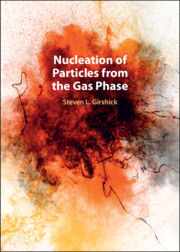Book contents
- Nucleation of Particles from the Gas Phase
- Reviews
- Nucleation of Particles from the Gas Phase
- Copyright page
- Dedication
- Contents
- Preface
- Symbols
- 1 Introduction
- 2 Single-Component Homogeneous Nucleation from a Supersaturated Vapor
- 3 Classical Nucleation Theory
- 4 Classical Theory of Multicomponent Nucleation
- 5 Classical Theory of Ion-Induced Nucleation
- 6 Atomistic Approaches to Homogeneous Nucleation
- 7 Transient Nucleation
- 8 Chemical Nucleation
- 9 Nucleation in Plasmas
- References
- Index
5 - Classical Theory of Ion-Induced Nucleation
Published online by Cambridge University Press: 30 May 2024
- Nucleation of Particles from the Gas Phase
- Reviews
- Nucleation of Particles from the Gas Phase
- Copyright page
- Dedication
- Contents
- Preface
- Symbols
- 1 Introduction
- 2 Single-Component Homogeneous Nucleation from a Supersaturated Vapor
- 3 Classical Nucleation Theory
- 4 Classical Theory of Multicomponent Nucleation
- 5 Classical Theory of Ion-Induced Nucleation
- 6 Atomistic Approaches to Homogeneous Nucleation
- 7 Transient Nucleation
- 8 Chemical Nucleation
- 9 Nucleation in Plasmas
- References
- Index
Summary
The late nineteenth-century Wilson cloud chamber experiments found that the presence of ions caused water vapor to nucleate at lower saturation ratios than in air free of ions. The classical theory of ion-induced nucleation is based on the Thomson model of an ionic droplet, in which an ionic core is surrounded by liquid of the condensing substance. A potential difference exists between the ionic core and the droplet surface, which introduces an electric work term into the Gibbs free energy of cluster formation. This term leads to the existence of stable prenuclei that are smaller than the critical size clusters and more abundant, at steady state, than the bare ions. With assumptions otherwise the same as in CNT for neutral self-nucleation, an expression can be derived for the steady-state rate of ion-induced nucleation. Deficiencies of this theory, in addition to those of CNT for neutral self-nucleation, include that it neglects the effect of the ion on condensation rate constants. Moreover, the theory predicts that the sign of the ion makes no difference in the nucleation rate, in contradiction to the results of most experimental studies for various substances.
Keywords
- Type
- Chapter
- Information
- Nucleation of Particles from the Gas Phase , pp. 107 - 121Publisher: Cambridge University PressPrint publication year: 2024

